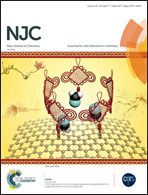CNT-enhanced amino-functionalized graphene aerogel adsorbent for highly efficient removal of formaldehyde†
Abstract
Graphene aerogels modified by two different methods were investigated for their capacities to adsorb gaseous formaldehyde. A CNT-enhanced graphene aerogel (GN/V) and an amino-functionalized graphene aerogel (G/E) were synthesized to improve the physical and chemical capabilities of graphene adsorbents for formaldehyde removal. CNTs were used to support and connect the graphene layers, thus weakening the aggregation effect and improving the microstructure. Ethylenediamine (EDA) was used as a reduction agent, instead of ascorbic acid (VC), to draw amino-functional groups into the graphene aerogels through the reaction with oxygen-containing groups on the graphene sheets. Chemical adsorption of formaldehyde via the reaction of amino groups (–NH2) and formaldehyde improved the adsorption performance, and the adsorption capacity reached 0.62 mg g−1. CNT-enhanced amino-functionalized graphene aerogels (GN/E) were synthesized using a combination of the two modification methods. Using a full three-dimensional network structure to both provide more adsorption sites and facilitate the chemical reaction with formaldehyde, the breakthrough time of GN/E reached 20 300 min g−1, and the adsorption capacity reached 27.43 mg g−1. The results indicate that chemical adsorption plays an important role in formaldehyde removal, and its combination with physical adsorption significantly enhances the performance.



 Please wait while we load your content...
Please wait while we load your content...